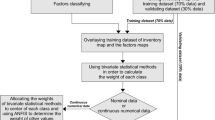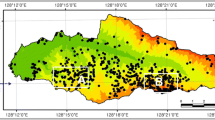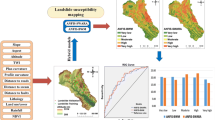Abstract
The main aim of this paper is to develop a new hybrid method to assess landslide susceptibility mapping (LSM) in neighboring provinces of Alborz Mountains in Iran. In the last centuries, this region has experienced a large number of landslides due to its location on earthquake belt, with high precipitation in some parts and having varied topography. Besides, the largest city of Iran (Tehran), a lot of important infrastructures, congested roads and a large population are located in this region. Therefore, determining the spatial outlines of the regions which are prone to future landslides is a critical issue. To reach this goal, the LSM is provided by applying a hybrid model of statistical index (Wi) and adaptive neuro-fuzzy inference system (ANFIS) in a Geographic Information System. In the first step, landslide inventory map was divided into two groups randomly. These groups are training dataset including 70 % recorded landslides and the remaining 30 % was used to test the model output. The first and second groups are used to determine the weights in model and validation of results, respectively. Then, 12 landslide conditioning factors are selected and categorized into two groups which are continuous numerical and nominal. After that, each factor is classified and the weight of each class is determined using Wi. The outputs of Wi and Wi-ANFIS were employed to determine nominal and continuous numerical data, respectively. In the Wi-ANFIS approach, the calculated weights of each class is allocated to the center of each class, and the rest weights of values are determined by ANFIS which is an artificial algorithm using training data (in this paper, the weights were calculated by Wi) in terms of predicting and interpolating. The results are evaluated using receiver operation curves including success rate curve and predicted rate curve. The validation results of the proposed hybrid method shows that the area under the curve of success rate curve and predicted rate curve are 0.90 and 0.89, respectively, which have been improved in comparison with Wi. The results pr oved that the suggested model applied in this study generated reliable LSM which can be applicable for primary land use planning and infrastructure site selection.














Similar content being viewed by others
References
Akgun A, Sezer EA, Nefeslioglu HA, Gokceoglu C, Pradhan B (2012) An easy-to-use MATLAB program (MamLand) for the assessment of landslide susceptibility using a Mamdani fuzzy algorithm. Comput Geosci 38:23–34. doi:10.1016/j.cageo.2011.04.012
Alakhras MN (2005) Neural network-based fuzzy inference system for exchange rate prediction. J Comput Sci 112–120
Alimohammadlou Y, Najafi A, Gokceoglu C (2014) Estimation of rainfall-induced landslides using ANN and fuzzy clustering methods: a case study in Saeen Slope, Azerbaijan province, Iran. Catena 120:149–162
Althuwaynee OF, Pradhan B, Lee S (2012) Application of an evidential belief function model in landslide susceptibility mapping. Comput Geosci 44:120–135
Aronoff S (1989) Geographic information systems: a management perspective. WDL Publications, Ottawa, p 294
Ayalew L, Yamagishi H (2005) The application of GIS-based logistic regression for landslide susceptibility mapping in the Kakuda-Yahiko Mountains, Central Japan. Geomorphology 65:15–31
Ayalew L, Yamagishi H, Marui H, Kanno T (2005) Landslides in Sado Island of Japan: Part II. GIS-based susceptibility mapping with comparisons of results from two methods and verifications. Eng Geol 81:432–445
Bai S, Wang J, Zhang Z, Cheng C (2012) Combined landslide susceptibility mapping after Wenchuan earthquake at the Zhouqu segment in the Bailongjiang Basin, China. Catena 99:18–25
Bolstad P (2005) GIS fundamentals: a first text on geographic information systems. Eider Press, Saint Paul
Bui DT, Pradhan B, Lofman O, Revhaug I, Dick OB (2012a) Landslide susceptibility assessment in the Hoa Binh province of Vietnam: a comparison of the Levenberg–Marquardt and Bayesian regularized neural networks. Geomorphology 171:12–29
Bui DT, Pradhan B, Lofman O, Revhaug I, Dick OB (2012b) Landslide susceptibility mapping at Hoa Binh province (Vietnam) using an adaptive neuro-fuzzy inference system and GIS. Comput Geosci 45:199–211
Bui DT, Pradhan B, Lofman O, Revhaug I, Dick OB (2012c) Spatial prediction of landslide hazards in Hoa Binh province (Vietnam): a comparative assessment of the efficacy of evidential belief functions and fuzzy logic models. Catena 96:28–40
Burrough PA (1986) Principles of geographical information systems for land resources assessment. Oxford university press, Oxford, p 193
Burroughs ER, Chalfant GR, Townsend MA (1976) Slope stability in road construction. US Department of the Interior, Bureau of Land Management, Oregon State Office, Portland, OR
Cevik E, Topal T (2003) GIS-based landslide susceptibility mapping for a problematic segment of the natural gas pipeline, Hendek (Turkey). Environ Geol 44:949–962
Che VB et al (2012) Landslide susceptibility assessment in Limbe (SW Cameroon): a field calibrated seed cell and information value method. Catena 92:83–98
Choi J, Oh H-J, Lee H-J, Lee C, Lee S (2012) Combining landslide susceptibility maps obtained from frequency ratio, logistic regression, and artificial neural network models using ASTER images and GIS. Eng Geol 124:12–23. doi:10.1016/j.enggeo.2011.09.011
Chung C-JF, Fabbri AG (2003) Validation of spatial prediction models for landslide hazard mapping. Nat Hazards 30:451–472
Conforti M, Pascale S, Robustelli G, Sdao F (2014) Evaluation of prediction capability of the artificial neural networks for mapping landslide susceptibility in the Turbolo River catchment (northern Calabria, Italy). Catena 113:236–250
Dai F, Lee C, Ngai YY (2002) Landslide risk assessment and management: an overview. Eng Geol 64:65–87
Dehnavi A, Aghdam IN, Pradhan B, Varzandeh MHM (2015) A new hybrid model using step-wise weight assessment ratio analysis (SWARA) technique and adaptive neuro-fuzzy inference system (ANFIS) for regional landslide hazard assessment in Iran. Catena 135:122–148
Dewitte O, Chung C-J, Cornet Y, Daoudi M, Demoulin A (2010) Combining spatial data in landslide reactivation susceptibility mapping: a likelihood ratio-based approach in W Belgium. Geomorphology 122:153–166. doi:10.1016/j.geomorph.2010.06.010
El-Shafie A, Taha MR, Noureldin A (2007) A neuro-fuzzy model for inflow forecasting of the Nile river at Aswan high dam. Water Resour Manag 21:533–556
Ercanoglu M, Gokceoglu C (2004) Use of fuzzy relations to produce landslide susceptibility map of a landslide prone area (West Black Sea Region, Turkey). Eng Geol 75:229–250
Fernandes NF, Guimarães RF, Gomes RA, Vieira BC, Montgomery DR, Greenberg H (2004) Topographic controls of landslides in Rio de Janeiro: field evidence and modeling. Catena 55:163–181
Florsheim JL, Nichols A (2013) Landslide area probability density function statistics to assess historical landslide magnitude and frequency in coastal California. Catena 109:129–138. doi:10.1016/j.catena.2013.04.005
Ghorbani M (2013) The economic geology of Iran: mineral deposits and natural resources. Springer Verlag Publication, Dordrecht, Netherlands, pp 572
Glade T, Anderson M, Crozier MJ (2005) Landslide hazard and risk. Wiley, New York
Guoqing Y, Haibo Y, Zhizong T, Baosen Z (2011) Landslide risk analysis of Miyun Reservoir area based on RS and GIS. Proc Environ Sci 10:2567–2573. doi:10.1016/j.proenv.2011.09.399
Haeri S, Satari M (1993) Great landslides triggered by Manjil Earthquake, 20 June 1990 Natural Disaster Reduction Center of Iran (in Persian)
Jang J-SR, Sun C-T, Mizutani E (1997) Neuro-fuzzy and soft computing-a computational approach to learning and machine intelligence [Book Review]. Autom Control IEEE Trans 42:1482–1484
Kavzoglu T, Sahin EK, Colkesen I (2013) Landslide susceptibility mapping using GIS-based multi-criteria decision analysis, support vector machines, and logistic regression. Landslides 11:425–439. doi:10.1007/s10346-013-0391-7
Kayastha P, Dhital M, De Smedt F (2013) Application of the analytical hierarchy process (AHP) for landslide susceptibility mapping: a case study from the Tinau watershed, west Nepal. Comput Geosci 52:398–408
Keefer DK (1984) Landslides caused by earthquakes. Geol Soc Am Bull 95:406–421
Keskin ME, Taylan D, Terzi O (2006) Adaptive neural-based fuzzy inference system (ANFIS) approach for modelling hydrological time series. Hydrol Sci J 51:588–598
Klir G, Yuan B (1995) Fuzzy sets and fuzzy logic, vol 4. Prentice Hall, New Jersey
Kumanan S, Jesuthanam C, Kumar RA (2008) Application of multiple regression and adaptive neuro fuzzy inference system for the prediction of surface roughness. Int J Adv Manuf Technol 35:778–788
Lee S, Pradhan B (2006) Landslide hazard mapping at Selangor. Malaysia using frequency ratio and logistic regression models. Landslides 4:33–41. doi:10.1007/s10346-006-0047-y
Lee S, Ryu J-H, Won J-S, Park H-J (2004) Determination and application of the weights for landslide susceptibility mapping using an artificial neural network. Eng Geol 71:289–302
Liu JP, Zeng ZP, Liu HQ, Wang HB (2011) A rough set approach to analyze factors affecting landslide incidence. Comput Geosci 37:1311–1317. doi:10.1016/j.cageo.2011.02.010
Marjanović M, Kovačević M, Bajat B, Voženílek V (2011) Landslide susceptibility assessment using SVM machine learning algorithm. Eng Geol 123:225–234. doi:10.1016/j.enggeo.2011.09.006
Mohammady M, Pourghasemi HR, Pradhan B (2012) Landslide susceptibility mapping at Golestan Province, Iran: a comparison between frequency ratio. Dempster-Shafer, and weights-of-evidence models. J Asian Earth Sci 61:221–236
Morshed Varzandeh MH, Rahbari O, Vafaeipour M, Raahemifar K, Heidarzadeh F (2014) Performance of neural wavelet and ANFIS algorithms for short-term prediction of solar radiation and wind velocities. In: The 4th world sustainability forum. Multidisciplinary Digital Publishing Institute
Neaupane KM, Piantanakulchai M (2006) Analytic network process model for landslide hazard zonation. Eng Geol 85:281–294
Nourani V, Pradhan B, Ghaffari H, Sharifi SS (2013) Landslide susceptibility mapping at Zonouz Plain. Iran using genetic programming and comparison with frequency ratio, logistic regression, and artificial neural network models. Nat Hazards 71:523–547. doi:10.1007/s11069-013-0932-3
Oh H-J, Pradhan B (2011) Application of a neuro-fuzzy model to landslide-susceptibility mapping for shallow landslides in a tropical hilly area. Comput Geosci 37:1264–1276
Ozdemir A, Altural T (2013) A comparative study of frequency ratio, weights of evidence and logistic regression methods for landslide susceptibility mapping: Sultan Mountains, SW Turkey. J Asian Earth Sci 64:180–197. doi:10.1016/j.jseaes.2012.12.014
Pavel M, Nelson JD, Jonathan Fannin R (2011) An analysis of landslide susceptibility zonation using a subjective geomorphic mapping and existing landslides. Comput Geosci 37:554–566. doi:10.1016/j.cageo.2010.10.006
Piacentini D, Troiani F, Soldati M, Notarnicola C, Savelli D, Schneiderbauer S, Strada C (2012) Statistical analysis for assessing shallow-landslide susceptibility in South Tyrol (south–eastern Alps, Italy). Geomorphology 151–152:196–206. doi:10.1016/j.geomorph.2012.02.003
Pourghasemi HR, Mohammady M, Pradhan B (2012) Landslide susceptibility mapping using index of entropy and conditional probability models in GIS: Safarood Basin, Iran. Catena 97:71–84
Pourghasemi HR, Jirandeh AG, Pradhan B, Xu C, Gokceoglu C (2013) Landslide susceptibility mapping using support vector machine and GIS at the Golestan Province, Iran. J Earth Syst Sci 122:349–369
Pradhan B (2013) A comparative study on the predictive ability of the decision tree, support vector machine and neuro-fuzzy models in landslide susceptibility mapping using GIS. Comput Geosci 51:350–365
Regmi AD, Devkota KC, Yoshida K, Pradhan B, Pourghasemi HR, Kumamoto T, Akgun A (2013) Application of frequency ratio, statistical index, and weights-of-evidence models and their comparison in landslide susceptibility mapping in Central Nepal Himalaya. Arab J Geosci 7:725–742. doi:10.1007/s12517-012-0807-z
Roodposhti MS, Rahimi S, Beglou MJ (2013) PROMETHEE II and fuzzy AHP: an enhanced GIS-based landslide susceptibility mapping. Nat Hazards 73:77–95. doi:10.1007/s11069-012-0523-8
Schicker R, Moon V (2012) Comparison of bivariate and multivariate statistical approaches in landslide susceptibility mapping at a regional scale. Geomorphology 161:40–57
Shahabi H, Khezri S, Ahmad BB, Hashim M (2014) Landslide susceptibility mapping at central Zab basin, Iran: a comparison between analytical hierarchy process, frequency ratio and logistic regression models. Catena 115:55–70. doi:10.1016/j.catena.2013.11.014
Sidle RC, Ochiai H (2006) Landslides: processes, prediction, and land use, vol 18. American Geophysical Union, Washington
Song K-Y, Oh H-J, Choi J, Park I, Lee C, Lee S (2012) Prediction of landslides using ASTER imagery and data mining models. Adv Space Res 49:978–993. doi:10.1016/j.asr.2011.11.035
Takagi T, Sugeno M (1985) Fuzzy identification of systems and its applications to modeling and control. Syst Man Cybern IEEE Trans:116–132
Tehrany MS, Pradhan B, Mansor S, Ahmad N (2015) Flood susceptibility assessment using GIS-based support vector machine model with different kernel types. Catena 125:91–101
Thiery Y, Malet J-P, Sterlacchini S, Puissant A, Maquaire O (2007) Landslide susceptibility assessment by bivariate methods at large scales: application to a complex mountainous environment. Geomorphology 92:38–59
Tien Bui D, Pradhan B, Lofman O, Revhaug I, Dick OB (2012) Landslide susceptibility assessment in the Hoa Binh province of Vietnam: a comparison of the Levenberg–Marquardt and Bayesian regularized neural networks. Geomorphology 171–172:12–29. doi:10.1016/j.geomorph.2012.04.023
Umar Z, Pradhan B, Ahmad A, Jebur MN, Tehrany MS (2014) Earthquake induced landslide susceptibility mapping using an integrated ensemble frequency ratio and logistic regression models in West Sumatera Province, Indonesia. Catena 118:124–135
Van Westen C (1997) Statistical landslide hazard analysis. ILWIS 2:73–84
Van Westen CJ, Castellanos E, Kuriakose SL (2008) Spatial data for landslide susceptibility, hazard, and vulnerability assessment: an overview. Eng Geol 102:112–131
Wilson JP, Gallant JC (2000) Terrain analysis: principles and applications. Wiley, New York
Shao W-y, Zhao C-w (2013) Application of combination to landslide hazard susceptibility assessment based on improved AHP and TOPSIS method: a case of Bijie, Guizhou Province. J Chongqing Normal Univ (Nat Sci) 3:009
Xu C, Xu X, Dai F, Saraf AK (2012) Comparison of different models for susceptibility mapping of earthquake triggered landslides related with the 2008 Wenchuan earthquake in China. Comput Geosci 46:317–329
Yalcin A (2008) GIS-based landslide susceptibility mapping using analytical hierarchy process and bivariate statistics in Ardesen (Turkey): comparisons of results and confirmations. Catena 72:1–12
Yalcin A, Reis S, Aydinoglu A, Yomralioglu T (2011) A GIS-based comparative study of frequency ratio, analytical hierarchy process, bivariate statistics and logistics regression methods for landslide susceptibility mapping in Trabzon, NE Turkey. Catena 85:274–287. doi:10.1016/j.catena.2011.01.014
Yao X, Tham L, Dai F (2008) Landslide susceptibility mapping based on support vector machine: a case study on natural slopes of Hong Kong, China. Geomorphology 101:572–582
Yilmaz I (2009) Landslide susceptibility mapping using frequency ratio, logistic regression, artificial neural networks and their comparison: a case study from Kat landslides (Tokat—Turkey). Comput Geosci 35:1125–1138
Youssef AM, Pradhan B, Jebur MN, El-Harbi HM (2014) Landslide susceptibility mapping using ensemble bivariate and multivariate statistical models in Fayfa area, Saudi Arabia. Environ Earth Sci 73:3745–3761. doi:10.1007/s12665-014-3661-3
Zadeh L (1965) Information and control. Fuzzy Sets 8:338–353
Zhu AX et al (2014) An expert knowledge-based approach to landslide susceptibility mapping using GIS and fuzzy logic. Geomorphology 214:128–138. doi:10.1016/j.geomorph.2014.02.003
Author information
Authors and Affiliations
Corresponding author
Rights and permissions
About this article
Cite this article
Aghdam, I.N., Varzandeh, M.H.M. & Pradhan, B. Landslide susceptibility mapping using an ensemble statistical index (Wi) and adaptive neuro-fuzzy inference system (ANFIS) model at Alborz Mountains (Iran). Environ Earth Sci 75, 553 (2016). https://doi.org/10.1007/s12665-015-5233-6
Received:
Accepted:
Published:
DOI: https://doi.org/10.1007/s12665-015-5233-6




